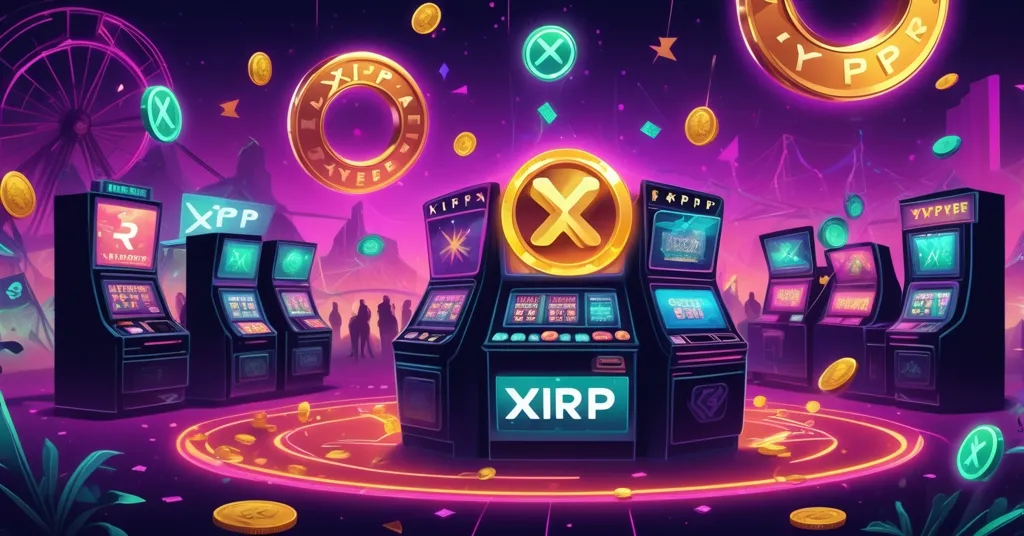XRP’s 11,200% Surge Hype: GENIUS Act Truth and XYZVerse Meme Coin Risks Exposed

XRP’s 11,200% Surge Hype: GENIUS Act Reality Check and XYZVerse Meme Coin Madness
A new U.S. law has crypto Twitter buzzing with claims of an 11,200% price explosion for XRP, while a presale meme coin, XYZVerse, dangles promises of 30x gains. But is there substance behind the speculation, or are we just witnessing another round of crypto fever dreams? Let’s cut through the hype with hard facts and sharp skepticism.
- XRP Surge Speculation: The GENIUS Act fuels talk of an 11,200% XRP rally, yet concrete ties to the legislation remain elusive.
- GENIUS Act Scope: A Senate-passed bill on stablecoin regulation, with no direct mention of XRP’s role or impact.
- XYZVerse Hype: A sports-branded meme coin in presale, projecting a 30x jump to $0.10, built on unverified claims and community buzz.
What Makes XRP Stand Out in the Crypto Game?
XRP, crafted by Jed McCaleb, Arthur Britto, and David Schwartz, isn’t just another digital token vying for attention. It’s built with a singular mission: to overhaul the clunky, expensive world of cross-border payments. Unlike Bitcoin, which shines as a store of value—often dubbed digital gold—but struggles with high fees and slower transaction times during network congestion, XRP delivers near-instant settlements for fractions of a cent. It acts as a bridge currency, smoothing out swaps between different fiat currencies without the need for banks or middlemen. Think of it as a universal translator for global money, making international transfers faster and cheaper than traditional systems like SWIFT, which can take days and charge hefty fees.
Ripple, the company behind XRP (originally known as OpenCoin Inc.), was allocated a massive share of the initial 100 billion XRP supply at launch. They’ve since leveraged this stash to enhance liquidity and forge partnerships with financial institutions worldwide. The potential market? A staggering $300 trillion in annual cross-border transaction volume by 2030, according to Ripple’s estimates. XRP’s value proposition is clear: if it can capture even a sliver of this market, its price could see serious upward pressure. But that’s a big “if,” and we’ll get to the roadblocks shortly.
GENIUS Act: Regulatory Tailwind or XRP Pipe Dream?
The GENIUS Act, passed by the U.S. Senate on May 19, 2025, has sparked wild speculation in crypto circles as a potential catalyst for XRP’s meteoric rise. This legislation primarily targets stablecoins—cryptocurrencies pegged to assets like the U.S. dollar to minimize price volatility—with the aim of creating a clearer regulatory framework. Proponents argue that a more defined legal landscape for digital assets could boost mainstream adoption of blockchain technology, indirectly benefiting tokens like XRP that have real-world utility, as outlined in discussions on online forums. Ripple’s Payments Product Lead, Pegah Soltani, has long championed XRP as a fix for the inefficiencies plaguing global payments—slow processing, high costs, and frequent errors.
Soltani envisions XRP as the backbone of instant, low-fee settlements across borders, a direct challenge to outdated financial systems.
But let’s not get carried away. While the GENIUS Act might signal a friendlier stance toward crypto, there’s no hard evidence tying it directly to XRP. The much-hyped “hidden trigger” behind the 11,200% surge narrative is nowhere to be found in public records or Senate debates. It’s just whispers and wishful thinking, amplified by overzealous online forums. And XRP isn’t out of the regulatory woods yet. The SEC’s lawsuit against Ripple, launched in 2020 over whether XRP qualifies as a security (which would impose stricter oversight), was dropped in March 2025—a win, no doubt. Yet lingering delays in approving spot XRP ETFs show that Washington’s trust in Ripple’s ecosystem is far from guaranteed. Without solid proof of the GENIUS Act’s impact, as explored in expert analyses, pinning hopes on a price jump from today’s roughly $0.50 to over $56 smells like pure fantasy.
XRP Price Potential: Dream Big, But Stay Grounded
Let’s talk numbers with a dose of realism. If XRP were to play a role in that projected $300 trillion cross-border payments market by 2030, even a tiny slice could drive significant value. Hypothetical models, based on transaction velocity—how often each XRP token is reused in transactions—suggest a price range of $10.21 to $510.64 per token. A midpoint of $51.06 at a velocity of 100 has been floated as a reasonable estimate, with some expert projections diving deeper into these possibilities. Now, capturing the entire market is laughably unrealistic; even 5-10% would be a Herculean achievement, potentially pushing XRP to $10-$50 long-term. Compare that to the 11,200% hype, and it looks less insane but still wildly optimistic without massive adoption.
Here’s the rub: adoption isn’t guaranteed. Banks and financial giants are slow to embrace blockchain tech, often preferring to upgrade existing systems like SWIFT rather than pivot to XRP. Competition from other networks, like Stellar, which also targets cross-border efficiency, adds pressure. And while Ripple boasts partnerships with institutions globally, actual transaction volumes using XRP remain a fraction of the hype. Regulatory clarity from bills like the GENIUS Act could help, as detailed in recent regulatory breakdowns, but history—think Bitcoin’s modest bumps post-regulatory wins—shows laws don’t automatically translate to price explosions. XRP has a niche Bitcoin doesn’t fill, and that’s worth rooting for as decentralization advocates. Still, let’s not pretend it’s a done deal.
XYZVerse: Meme Coin Mania or Another Crash Waiting to Happen?
Now, let’s pivot to XYZVerse ($XYZ), a presale meme coin priced at $0.003333, with bold projections of hitting $0.10 post-launch—a 30x leap. The pitch gets spicier with talk of an all-time high between $0.15 and $0.25 within weeks, and even $0.20 to $0.40 within 6-12 months. Built on sports branding and influencer buzz, $XYZ aims to mimic the viral success of meme coins like PEPE, Dogwifhat, and Bonk, which rode community fervor to staggering gains. Its tokenomics—basically, how supply and distribution are managed to influence price—include a deflationary burn of 17.13% to shrink supply over time, 15% allocated for liquidity to ease trading, and 10% for community rewards to keep the hype alive. Success supposedly depends on listings with heavyweights like KuCoin, OKX, or Binance, plus a bullish altcoin season (when smaller tokens surge after Bitcoin’s gains), as discussed in community reviews.
Sounds like a jackpot, right? Not so fast. This entire narrative stinks of speculative nonsense, backed by zero independent proof. The content pushing $XYZ is marked as sponsored, meaning someone paid to pump it, and there’s no trace of confirmed partnerships, exchange deals, or even a credible team behind it, as highlighted in a detailed risk assessment. Meme coins are the Wild West of crypto—entertaining when they moon, soul-crushing when they flop. For every Dogecoin, there are dozens of rug pulls, where developers ditch the project after pocketing investor cash. The fine print on $XYZ admits the high-risk nature of this gamble, and that’s the only honest bit of the story. With altcoin season allegedly looming, $XYZ might catch some FOMO-driven momentum, but betting on a 30x return without substance is like playing roulette with your rent money. If meme coins were a casino, $XYZ would be the flashy slot machine screaming “jackpot”—don’t bet the house just yet, as pondered in investment debates.
Key Questions and Takeaways for Crypto Fans
- What’s the actual link between the GENIUS Act and XRP?
It’s a stablecoin regulation bill passed by the U.S. Senate in 2025, potentially positive for crypto broadly, but no direct connection to XRP or an 11,200% surge exists—it’s all speculation. - Can XRP truly lead in cross-border payments?
Its tech offers fast, cheap transactions, and snagging even 5-10% of a $300 trillion market could drive prices to $10-$50 long-term, though bank adoption and competition pose major hurdles. - Is XYZVerse a real opportunity or pure hype?
With no verifiable backing and a paid promotion, it’s a risky bet—meme coins can spike, but most collapse without genuine value or trust. - How should you navigate hyped-up crypto claims?
Approach with caution, dig into primary sources, and resist FOMO—XRP has potential but faces obstacles, while $XYZ is a speculative long shot at best. - Where does Bitcoin fit in all this noise?
Unlike XRP’s niche utility or $XYZ’s fleeting buzz, Bitcoin remains the unshakable foundation of crypto as digital gold, prioritizing stability over speculative frenzies.
Stepping back, the crypto space is a chaotic mix of groundbreaking ideas and outright scams. XRP’s case for transforming global payments holds water, especially if regulatory shifts like the GENIUS Act pave the way for wider blockchain uptake. But banking on an 11,200% surge with no evidence is a sucker’s bet. Meanwhile, XYZVerse embodies the reckless allure of meme coins—fun to watch, dangerous to touch. As advocates for decentralization, privacy, and shaking up the broken financial system, we’re all about pushing this revolution forward with effective accelerationism. XRP fills a gap Bitcoin doesn’t tackle directly, and that’s valuable in this ecosystem. But let’s call a spade a spade: most meme coins like $XYZ are just noise, not innovation. Stay skeptical, prioritize Bitcoin’s long-term strength, and don’t get suckered by every shiny promise of overnight riches—because nine times out of ten, it’s pure, unadulterated bullshit.



